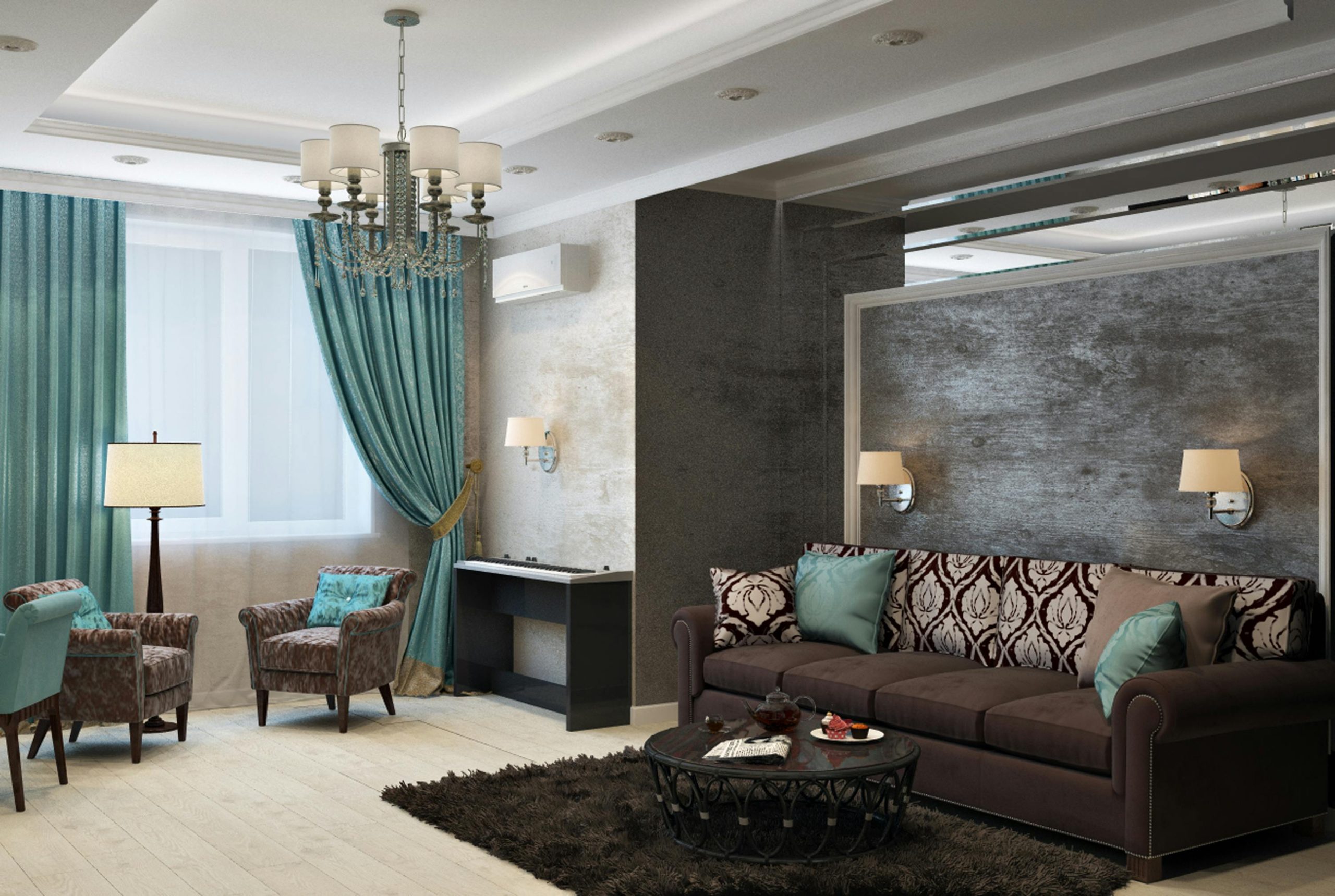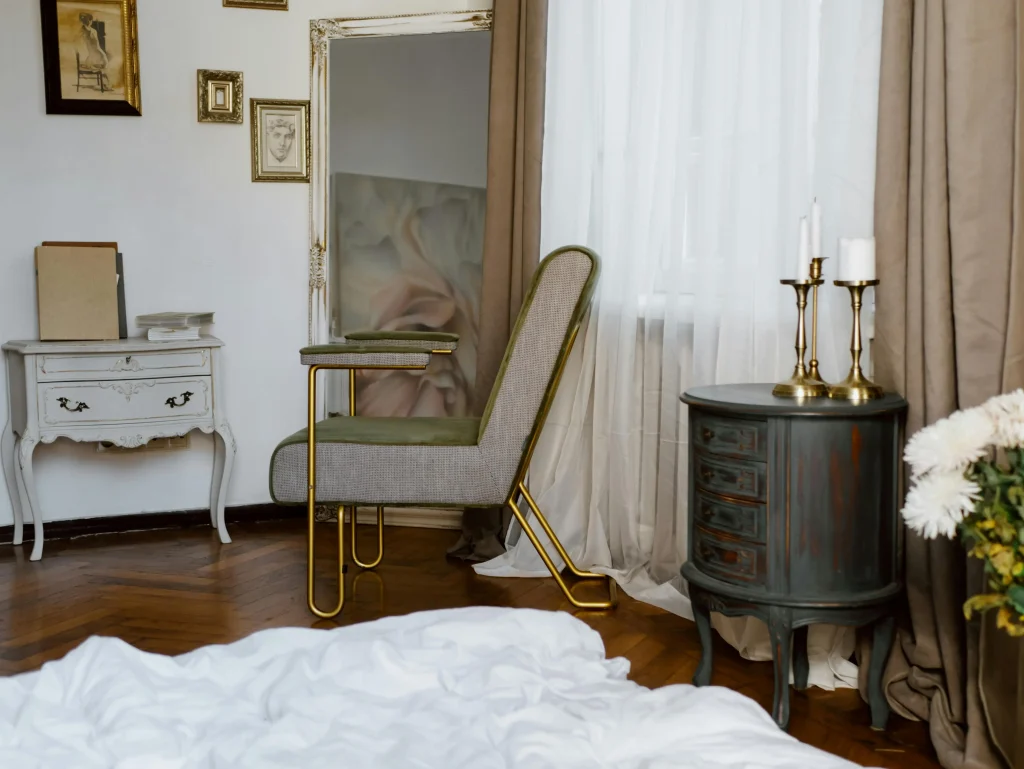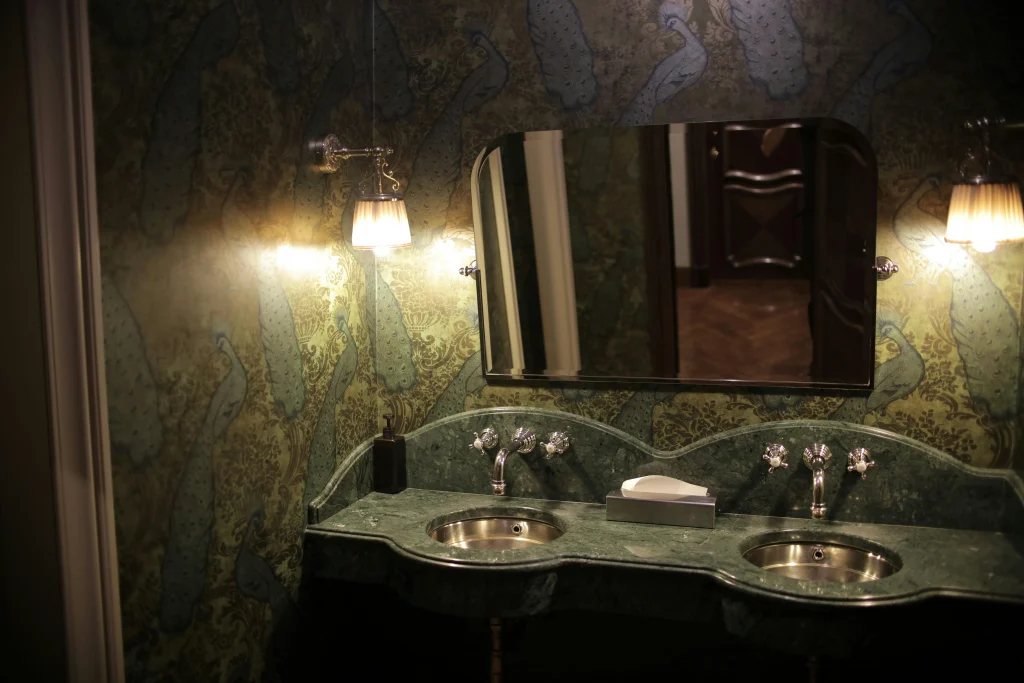Our Location
304 North Cardinal St.
Dorchester Center, MA 02124

The – 1960s house interior design was the iconoclastic period in interior design and such features as radicalness of colors, geometry and futuristic style still thrill people and designers nowadays. The design of the houses built in the 1960s is full of inspiration whether you are trying to bring back life to your mid-century modern house or even restore it quickly and simply, you can bring a retro mood. This classic decade was a merge between utility and art, and this aesthetic brought comfort and fashion that has not worn out yet.
Open floor plans, sunken living rooms, low-defined furniture, and natural woods such as teak and walnut are common in a 1960s inspired interior. Bright colors were used in combination with coarse white or black color of paint, such as mustard yellow, avocado green and burnt orange. Starburst clocks, shag rugs and abstract artwork bring off an air of character and charm whilst statement lighting makes a statement with arc floor lamps or bubble pendant lights.
In modern times, these retro decorations are being combined and integrated by homeowners with a contemporary mindset, thus giving their rooms the look of being retro-trendy and at the same time being a breath of fresh air. By taking on the signature style of house decor of the 1960s, you can make your house become a beautiful place of the past imbued with futuristic values. Immerse yourself in our nuggets of our favorite ideas that reintroduce this memorable era with pizazz and ingenuity.
Mid-century modern aesthetic is one of the characteristic factors of house interior design in the times of 1960s. Practical furniture, simple lines and striking accentuate designs are the main characteristics of this style that became a source of inspiration in modern interiors. The design of the house interior of 1960s retains its sophistication, which feels much more like a chic blast from the past. The furniture during this period was low profiled, wood framed and had tapered legs that gave a room a sleek and streamlined appearance.
Colour schemes could also be neutral with a base of white, beige or gray with bright accent of colour such as burnt orange, olive-green, and mustard-yellow. Rugs and curtains should feature geometric patterns when you want a genuine 60s house interior, and, complimenting it, you can use such strong light decorations as an arc lamp or a Sputnik chandelier. These omnipresent factors produce a strong retro style that still evokes a fresh feeling nowadays.
Key Tips:

One of the most vivid features of the 1960s house interior is the fact that vivid colors and contrasting patterns have no fears. The body of this period was about being individualistic, displaying in bright colors and seeing impressions. The colors of the palette, ranging all the way to avocado green, burnt orange, to mustard yellow, were not demure at all. These courageous decisions gave the interior an energy and warmth and made the rooms look cheerful and special.
Colorful wallpaper, patterned upholstery or patterned area rugs are a good way to capture the look of interior design of the house of the 1960s. The popular patterns were floral, paisley, and geometric patterns almost used in everything including the curtains and cushions. The trick is to counteract these loud elements with strong tones to prevent the place being dominated. You can just get the same appearance, but the impression is more vintage but modern at the same time.
Key Tips:

Lighting is another important factor that helps to dwell upon the appeal of the 1960s house interior design. The light in this epoch was not only functional; it was the message as well. Classic models such as Sputnik chandeliers, arc floor lamps and globe pendant lights found their epicentre in living rooms, diner rooms and bedrooms. These lights did not only light the space, but also gave it some artistic and futuristic flair that characterised the decade.
In order to remain faithful to the house interior design in the 1960s, you should go with lighting that has metallic colors such as brass or chrome. Try to find items of unusual forms- orb round chandeliers, starburst patterns or multi arms. Those retro lighting features add warmth, character and drama to any room. Going retro or vintage with your home design or simply applying the vintage touch to a contemporary one, the lighting can change an atmosphere completely.
Key Tips:

Chief amongst the features of house design of the 1960s interior is the predominant use of the natural materials in wood and other organic materials. This was an indication of appreciation of nature and simplicity that was increasingly being valued in the decade. Usually walnut, teak, and oak wood was widely patented in floors, furnishings, the walls, and cabinets. These materials gave warmth and down-to-earth tone to interior spaces adding a perfect contrast to innovative colors and furniture commonly used at that period of time.
To exact a genuine 1960s house interior design, use wood colors on your coffee tables, dressers, dining rooms, or shelves. Combine them with woven materials, leather or even stone to generate a layered and haptic setting. Such grounded style introduces some sort of balance and elegance and your arrangement will always be antique and comfortable.
Key Tips:
The open floor plan started to be very characteristic of the interior design of houses in the 60s of the XX century as a move towards a more informal and more communal style of life. Partitioning of rooms traditionally assumed a form into a smooth space which promoted socialization and the use of natural light. Dining rooms appeared to transform with living rooms and kitchens, making the space better functional and, hence, conducive to a good party (or a family gathering).
In order to implement this principle in the interior style of your own house of the 1960s, think of creating the space using furniture pieces rather than the wall or removing the existing superfluous walls. Low profile sofas, area rugs, an open-shelving all are used to create areas and still keep the airy, unblocked feel. An important addition also was the large windows, and sliding glass doors that opened the outdoors into the home and made the home feel like a much larger house.
Key Tips:
In house interior perfection in the 1960s, accessories played a crucial role in shaping up the personality. Those well thought out accents added color, texture, and unique retro style even to the most basic rooms. One can think of starburst clocks, rotary telephone, ceramic vases, lava lamps and pop art prints all of which added to the playful and daring nature of the 60s. In the 1960s house interior, the accessories were more than pieces of decoration, they were the points to a conversation and even a replica of the inventiveness of those times.
Bring real 60s to your room by using antique items in flea markets or new versions. Walls artwork or decorations that are extremely colorful or cultural icons such as Marilyn Monroe or Beatles will provide a real touch. Retro mirrors, record-players, or funky planters will not be able to make up your look.
Key Tips:
Another major characteristic of house interior design in the 60s is the introduction of such low-profiled sleazy furniture that puts more focus on simplicity and comfort. The pieces of furniture made during this period were characterized by a minimalist design style incorporating clean lines, clean shapes and functional designs that were both form and practical at the same time. There were tapered wooden legs, the sofas and chairs were often kept closer to the ground, and the living spaces with their minimalistic styles were more open and airy. This style adds to the clutter free and fancy environment that is associated with the interior design of houses in the 1960s.
To achieve this style, select items that are either created out of natural wood, leather or vinyl, and when selecting items, do not resort to excessively gilded details. Modular soćapas, sleek coffee tables, and minimalistic shelving systems will help keep the look. The minimalism in terms of function but preserving style makes the 1960s house interior design timeless and easily adaptable to the contemporary houses.
Key Tips:
A major characteristic of the 1960s house interior design is geometric shapes and patterns. This decade rejoiced in the edgy, abstract shapes that gave more energy and movements to the interior spaces. Geometric shape wallpaper, textiles, and furniture, and decoration, circles, triangles, chevrons and diamonds, gave the house a light-hearted but, at the same time, elegant atmosphere. These designs commonly used contrasting colors in order to generate vitality in the images.
In order to introduce this aspect to the interior design of your own 1960s house, apply geometric-patterned carpets, pillows or drapes. Abstract-shaped or vintage-looking graphic wall prints may also be rather striking. When combined with sturdy colors and a clear-line upholstering in furniture these textures will keep everything in balance, though with the look of a vintage 60s house.
Key Tips:
The wall decoration is one of the distinctive characteristics of the house interior design of the 1960s as the wall art or murals make a room individual and lively. The 60s were full of colorful and brave artworks which were usually affected by the influence of pop art, psychedelic ideas and abstract designs. Focal points can be in the form of large scale murals or graphical prints and it can turn dull walls to interactive canvases.
To reproduce this element of 60s house interior design in a pure form, you may include retro posters, framed art pieces or murals with the images depicting the characteristic motives of the 60s. These provided color and personality and echoed the decade of creativity. Combine wall art with any other furniture and accessories that match with it to keep the room consistent and not to stuff it.
Key Tips:
Mixing modern elements with older accents is just one of the best ways of keeping the 1960s house interior design on the finger tips today. This style will relieve the retro in that style and be sure that your space is modern and practical. Blending of the eras will enable you to develop an original appearance that does not look out-of-date.
Use old 1960s furniture or accessories, e.g. a teak sideboard or a Sputnik chandelier, and combine them with more modern furniture, e.g. streamlined sofas, simple rugs or contemporary art. Such a combination of the old and the new shows the attractiveness of interior design of the houses of the 1960s and modifies it to the contemporary household. Considerately lay textures and colors to create a balance and create a feeling of the eye.
Key Tips:
Fabrics that had texture were also a major component of house interior designing in the 1960s, and brought depths as well as touch to the interiors. Boucle, velvet, tweed, and shag carpeting were the popular materials that provided a comfortable stylish room. Those fabrics applied on sofas, armchairs, cushions, and curtains produced friendly and visually-rich environments.
When you are doing a room that has the influence of house interior design of the 1960s, think of incorporating a variety of textures, so that it is not flat. As an example, one can take a velvet sofa and coupe it with boucle cushions and a shag rug to recreate the atmosphere of the era and its eclecticism. Textured fabrics contribute more than comfort, bringing the sense of the retro style by recreating the physical feel of the time.
Key Tips:
During house interior design in the 1960s, the indoor idea was well used with the subsequent effect of introducing living and freshness into homes. During the decade, there was an increase in biophilic design, which incorporated natural features into making indoor and outdoor harmonious. A trendy spider plant, rubber tree, and fern were standard house trends to be proudly mounted in beautiful pots and macrames, which enhanced the texture and gave a relaxing atmosphere.
Introducing green elements not only expands the visual space, but also makes contrast to the natural materials and vibrant colors of interior decor of a house in the 1960s. Geometric patterns which are used to harden furniture lines and geometric shapes of rooms are neutralized by adding plants in the rooms so that rooms are habitable and balanced since they are not too geometric. As a way of getting in with this trend, by maximizing style and lighting up the air, plants should be placed strategically, at corners, shelves and hanging around windows.
Key Tips:
The style of 1960s house interior design is quite attractive by its original combination of daring imagination and classic liberty. You can immerse into the atmosphere of the 60s at home by using mid-century modern furniture, bright colors, geometricism, and using natural materials. Are you crazy about having the whole vintage style or you just want to add some retro elements? This decor style will have something to offer to you, no matter what your taste is.
The combination of iconic light fixtures, textured materials and indoor plants will make your place stylish, comfortable and unique. Above all, the house interior design of the 1960s promotes uniqueness and lighthearted expression granting you with the ability to render it to the home that can fully lie in your style.
Introduce the retro revival and run inspirational 1960s redesign ideas to make your home trendy but still fresh in terms of the current lifestyle.
1. What are the main Characteristics of the house interior design of The 1960s?
The main Aspects are furniture mid_century modern_ Loud colors Such as mustard and avocado green_ Geometrical patterns_ wood elements_ and accent Lamps like Sputnik chandeliers. This style is very simple combined with colorful playful details.
2. What are some ideas to use house interior design of the 1960s in my house these days?
It is possible to mix old 60s-era furniture and items with modern furniture and items. The revival of the classic style should be peppered with retro color schemes, geometric patterns, and iconic lighting though the overall picture should remain clean and should not be cluttered.
3. Which colors are common in the interior design in a house in the 1960s?
Some of the common colors are mustard yellow, burnt orange, avocado green, teal and warm brown. These striking shades are mostly combined with the color of grays, whites, or beiges to present balanced and eyeful rooms.
4. What are the styles of the furniture that symbolize 1960s house interior design?
The interiors of the 1960s are characterized by low profile, sleek furniture with tapered legs which are usually teak or walnut. Diverse sofas of the modular style, minimum coffee tables, and plain-faced sideboards are usual options.
5. Just how significant are lighting fixtures in house design interiors in the 1960s?
The importance of lighting is tremendous. Memorable pieces such as the Sputnik chandeliers, arc floor lamps and globe pendants fulfill the role of both practical and artistic pieces, being used as landmark objects that enrich the image of the retro laboratory.
Related Article: 12 Stunning Ranch House Interior Design Ideas for a Cozy, Stylish Home